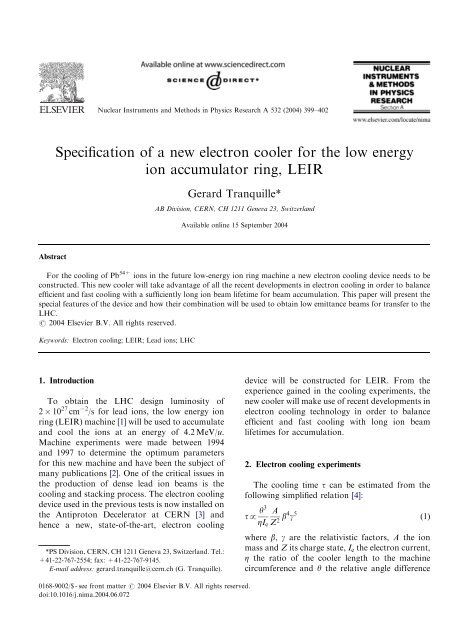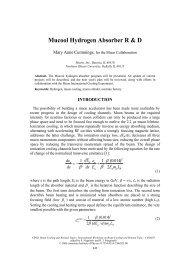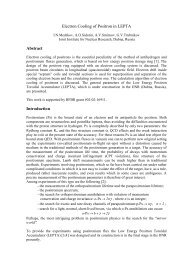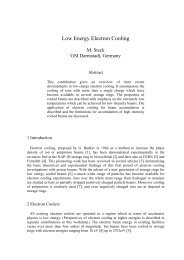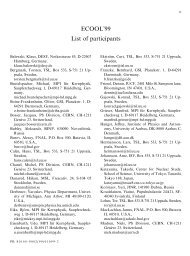Specification of a new electron cooler for the low energy ion ...
Specification of a new electron cooler for the low energy ion ...
Specification of a new electron cooler for the low energy ion ...
Create successful ePaper yourself
Turn your PDF publications into a flip-book with our unique Google optimized e-Paper software.
Abstract<br />
Nuclear Instruments and Methods in Physics Research A 532 (2004) 399–402<br />
<strong>Specificat<strong>ion</strong></strong> <strong>of</strong> a <strong>new</strong> <strong>electron</strong> <strong>cooler</strong> <strong>for</strong> <strong>the</strong> <strong>low</strong> <strong>energy</strong><br />
<strong>ion</strong> accumulator ring, LEIR<br />
Gerard Tranquille*<br />
AB Divis<strong>ion</strong>, CERN, CH 1211 Geneva 23, Switzerland<br />
Available online 15 September 2004<br />
For <strong>the</strong> cooling <strong>of</strong> Pb 54+ <strong>ion</strong>s in <strong>the</strong> future <strong>low</strong>-<strong>energy</strong> <strong>ion</strong> ring machine a <strong>new</strong> <strong>electron</strong> cooling device needs to be<br />
constructed. This <strong>new</strong> <strong>cooler</strong> will take advantage <strong>of</strong> all <strong>the</strong> recent developments in <strong>electron</strong> cooling in order to balance<br />
efficient and fast cooling with a sufficiently long <strong>ion</strong> beam lifetime <strong>for</strong> beam accumulat<strong>ion</strong>. This paper will present <strong>the</strong><br />
special features <strong>of</strong> <strong>the</strong> device and how <strong>the</strong>ir combinat<strong>ion</strong> will be used to obtain <strong>low</strong> emittance beams <strong>for</strong> transfer to <strong>the</strong><br />
LHC.<br />
r 2004 Elsevier B.V. All rights reserved.<br />
Keywords: Electron cooling; LEIR; Lead <strong>ion</strong>s; LHC<br />
1. Introduct<strong>ion</strong><br />
To obtain <strong>the</strong> LHC design luminosity <strong>of</strong><br />
2 10 27 cm 2 /s <strong>for</strong> lead <strong>ion</strong>s, <strong>the</strong> <strong>low</strong> <strong>energy</strong> <strong>ion</strong><br />
ring (LEIR) machine [1] will be used to accumulate<br />
and cool <strong>the</strong> <strong>ion</strong>s at an <strong>energy</strong> <strong>of</strong> 4.2 MeV/u.<br />
Machine experiments were made between 1994<br />
and 1997 to determine <strong>the</strong> optimum parameters<br />
<strong>for</strong> this <strong>new</strong> machine and have been <strong>the</strong> subject <strong>of</strong><br />
many publicat<strong>ion</strong>s [2]. One <strong>of</strong> <strong>the</strong> critical issues in<br />
<strong>the</strong> product<strong>ion</strong> <strong>of</strong> dense lead <strong>ion</strong> beams is <strong>the</strong><br />
cooling and stacking process. The <strong>electron</strong> cooling<br />
device used in <strong>the</strong> previous tests is now installed on<br />
<strong>the</strong> Antiproton Decelerator at CERN [3] and<br />
hence a <strong>new</strong>, state-<strong>of</strong>-<strong>the</strong>-art, <strong>electron</strong> cooling<br />
*PS Divis<strong>ion</strong>, CERN, CH 1211 Geneva 23, Switzerland. Tel.:<br />
+41-22-767-2554; fax: +41-22-767-9145.<br />
E-mail address: gerard.tranquille@cern.ch (G. Tranquille).<br />
ARTICLE IN PRESS<br />
0168-9002/$ - see front matter r 2004 Elsevier B.V. All rights reserved.<br />
doi:10.1016/j.nima.2004.06.072<br />
device will be constructed <strong>for</strong> LEIR. From <strong>the</strong><br />
experience gained in <strong>the</strong> cooling experiments, <strong>the</strong><br />
<strong>new</strong> <strong>cooler</strong> will make use <strong>of</strong> recent developments in<br />
<strong>electron</strong> cooling technology in order to balance<br />
efficient and fast cooling with long <strong>ion</strong> beam<br />
lifetimes <strong>for</strong> accumulat<strong>ion</strong>.<br />
2. Electron cooling experiments<br />
The cooling time t can be estimated from <strong>the</strong><br />
fol<strong>low</strong>ing simplified relat<strong>ion</strong> [4]:<br />
tp y3<br />
ZIe<br />
A<br />
Z 2 b4 g 5<br />
ð1Þ<br />
where b, g are <strong>the</strong> relativistic factors, A <strong>the</strong> <strong>ion</strong><br />
mass and Z its charge state, I e <strong>the</strong> <strong>electron</strong> current,<br />
Z <strong>the</strong> ratio <strong>of</strong> <strong>the</strong> <strong>cooler</strong> length to <strong>the</strong> machine<br />
circumference and y <strong>the</strong> relative angle difference
400<br />
between <strong>the</strong> <strong>ion</strong>s and <strong>the</strong> <strong>electron</strong>s. From <strong>the</strong><br />
above relat<strong>ion</strong> one sees that a number <strong>of</strong> machine<br />
and <strong>cooler</strong> parameters can influence <strong>the</strong> cooling<br />
time. In our experiments <strong>the</strong> main points <strong>of</strong><br />
investigat<strong>ion</strong> were<br />
* The <strong>ion</strong> beam lifetime as a funct<strong>ion</strong> <strong>of</strong> <strong>the</strong><br />
<strong>electron</strong> beam intensity.<br />
* The influence <strong>of</strong> <strong>the</strong> machine lattice parameters<br />
on <strong>the</strong> cooling time.<br />
* The cooling time versus <strong>the</strong> <strong>electron</strong> beam<br />
intensity and <strong>the</strong> <strong>cooler</strong> length.<br />
* Testing <strong>of</strong> stacking modes.<br />
* Stack equilibrium emittances and emittance<br />
growth.<br />
2.1. Ion beam lifetime<br />
The lifetime <strong>of</strong> <strong>the</strong> lead <strong>ion</strong> beam in <strong>the</strong> presence<br />
<strong>of</strong> an <strong>electron</strong> beam was measured <strong>for</strong> a number <strong>of</strong><br />
charge states around 53+. An anomalously fast<br />
recombinat<strong>ion</strong> rate <strong>for</strong> Pb 53+ was observed in<br />
initial measurements and <strong>for</strong>ced us to switch to a<br />
charge state <strong>of</strong> 54+. This unusually high rate<br />
points to mechanisms o<strong>the</strong>r than radiative or<br />
di<strong>electron</strong>ic capture and has been observed at<br />
o<strong>the</strong>r heavy <strong>ion</strong> storage rings.<br />
2.2. Influence <strong>of</strong> <strong>the</strong> lattice parameters on <strong>the</strong><br />
cooling time<br />
Special importance was attached to <strong>the</strong> dependence<br />
<strong>of</strong> <strong>the</strong> cooling time on <strong>the</strong> optical parameters<br />
<strong>of</strong> <strong>the</strong> storage ring. For a given emittance<br />
and momentum spread, <strong>the</strong> lattice parameters b<br />
and D determine <strong>the</strong> size and angular distribut<strong>ion</strong><br />
<strong>of</strong> <strong>the</strong> <strong>ion</strong> beam. Cooling times were measured <strong>for</strong><br />
a wide range <strong>of</strong> lattice parameters at <strong>the</strong> <strong>cooler</strong><br />
with protons at 50 MeV and Pb <strong>ion</strong>s at 4.2 MeV/u.<br />
Contrary to what one would expect from <strong>the</strong>ory,<br />
<strong>the</strong> best cooling was obtained <strong>for</strong> intermediate b<br />
values. It should however be ment<strong>ion</strong>ed that <strong>for</strong><br />
<strong>the</strong>se machine settings a non-zero value <strong>of</strong> <strong>the</strong><br />
dispers<strong>ion</strong> funct<strong>ion</strong> was set in <strong>the</strong> <strong>cooler</strong> sect<strong>ion</strong>. It<br />
is clear that <strong>the</strong> influence <strong>of</strong> D is superimposed on<br />
<strong>the</strong> bh dependence and may even be <strong>the</strong> dominant<br />
effect.<br />
ARTICLE IN PRESS<br />
G. Tranquille / Nuclear Instruments and Methods in Physics Research A 532 (2004) 399–402<br />
Guided by <strong>the</strong>se observat<strong>ion</strong>s a series <strong>of</strong><br />
measurements were made where only <strong>the</strong> dispers<strong>ion</strong><br />
funct<strong>ion</strong> was varied and <strong>the</strong> cooling times as a<br />
funct<strong>ion</strong> <strong>of</strong> <strong>the</strong> difference in beam alignment was<br />
recorded. The results showed that with a finite<br />
dispers<strong>ion</strong> in <strong>the</strong> <strong>cooler</strong> <strong>the</strong> cooling times could be<br />
halved and, depending on <strong>the</strong> sign <strong>of</strong> <strong>the</strong> dispers<strong>ion</strong><br />
funct<strong>ion</strong>, cooling was faster <strong>for</strong> positive or<br />
negative <strong>of</strong>fsets in beam posit<strong>ion</strong>.<br />
2.3. Cooling time versus <strong>electron</strong> current and <strong>cooler</strong><br />
length<br />
In <strong>the</strong> 1997 experiments <strong>the</strong> <strong>cooler</strong> length was<br />
doubled from 1.5 to 3 m. This enabled us to<br />
complement <strong>the</strong> cooling time measurements as a<br />
funct<strong>ion</strong> <strong>of</strong> I e with <strong>the</strong> variable Z. The results show<br />
that <strong>the</strong> linear increase in cooling rate, 1/t, asa<br />
funct<strong>ion</strong> <strong>of</strong> Ie and Z shows uponly <strong>for</strong> <strong>low</strong> <strong>electron</strong><br />
currents (o120 mA). Possible explanat<strong>ion</strong>s include<br />
<strong>the</strong> effect <strong>of</strong> <strong>the</strong> <strong>electron</strong> beam space charge<br />
increasing <strong>the</strong> mean transverse velocity <strong>of</strong> <strong>the</strong><br />
beam, misalignment tolerances, which are more<br />
critical <strong>for</strong> a longer <strong>cooler</strong>, and <strong>electron</strong> beam<br />
instabilities observed at high currents due to <strong>the</strong><br />
gun design.<br />
2.4. Stacking tests and equilibrium emittances<br />
Cooling and stacking tests were per<strong>for</strong>med with<br />
<strong>the</strong> lead <strong>ion</strong> injector Linac cycling at a repetit<strong>ion</strong><br />
rate <strong>of</strong> 2.5 Hz. The <strong>ion</strong> beam was injected using a<br />
combined horizontal and longitudinal multi-turn<br />
inject<strong>ion</strong> scheme enabling upto 1.5 10 8 <strong>ion</strong>s to<br />
be injected per Linac pulse. After inject<strong>ion</strong> into <strong>the</strong><br />
ring <strong>the</strong> beam is cooled in all three planes and<br />
‘dragged’ to <strong>the</strong> stack momentum leaving space <strong>for</strong><br />
<strong>the</strong> fol<strong>low</strong>ing pulse 400 ms later. This process is<br />
repeated until <strong>the</strong> losses during <strong>the</strong> interval<br />
between consecutive pulses balance <strong>the</strong> number<br />
<strong>of</strong> particles added per inject<strong>ion</strong>. On average<br />
6 10 8<br />
<strong>ion</strong>s were accumulated in about 10<br />
inject<strong>ion</strong>s with peaks reaching 7 10 8 <strong>ion</strong>s.<br />
The stack emittance was measured as a funct<strong>ion</strong><br />
<strong>of</strong> stack intensity and <strong>the</strong> cooling was switched <strong>of</strong>f<br />
to record <strong>the</strong> emittance growth. The results show<br />
that <strong>for</strong> <strong>the</strong> required LHC intensity, <strong>the</strong> emittance,
even 1 s after cooling is switched <strong>of</strong>f, should be<br />
well be<strong>low</strong> <strong>the</strong> 0.7 mm limit.<br />
The saturat<strong>ion</strong> at a stacking factor <strong>of</strong> about 7,<br />
indicates a lifetime <strong>of</strong> only 2.6 s. This short lifetime<br />
is probably explained by <strong>the</strong> increased charge<br />
exchange due to outgassing caused by inject<strong>ion</strong><br />
losses. In <strong>the</strong> future LEIR machine, special<br />
attent<strong>ion</strong> must be paid to <strong>the</strong> vacuum system and<br />
<strong>the</strong> inject<strong>ion</strong> process.<br />
3. The LEIR <strong>electron</strong> <strong>cooler</strong><br />
The <strong>electron</strong> cooling device (Fig. 1) planned <strong>for</strong><br />
LEIR is conceptually similar to <strong>the</strong> <strong>cooler</strong>s in<br />
operat<strong>ion</strong> at CERN and o<strong>the</strong>r laboratories. It is<br />
designed to cool and accumulate pulses <strong>of</strong> a few<br />
10 7 <strong>ion</strong>s in less than 200 ms.<br />
Taking into account recent improvements [5,6]<br />
tested on various <strong>electron</strong> <strong>cooler</strong>s during <strong>the</strong> last<br />
decade, we <strong>for</strong>esee <strong>the</strong> use <strong>of</strong> a high perveance gun<br />
fol<strong>low</strong>ed by an adiabatic expans<strong>ion</strong> (A) provided<br />
by an addit<strong>ion</strong>al solenoid. A 90 toroid (B+C)<br />
bends <strong>the</strong> <strong>electron</strong>s into <strong>the</strong> 2.5 m cooling sect<strong>ion</strong><br />
(D) where <strong>the</strong>y merge with <strong>the</strong> circulating <strong>ion</strong>s. A<br />
second toroid (E+F) bends <strong>the</strong> <strong>electron</strong>s out <strong>of</strong><br />
<strong>the</strong> cooling sect<strong>ion</strong> towards <strong>the</strong> collector (G) where<br />
<strong>the</strong> <strong>electron</strong> beam power is recovered.<br />
3.1. The <strong>electron</strong> gun<br />
The high perveance gun aims at providing an<br />
<strong>electron</strong> beam with a high density in order to<br />
decrease <strong>the</strong> cooling rate. For LEIR 600 mA <strong>of</strong><br />
<strong>electron</strong> current will be required <strong>for</strong> cooling Pb<br />
<strong>ion</strong>s at an <strong>electron</strong> <strong>energy</strong> <strong>of</strong> 2.3 keV. In addit<strong>ion</strong>,<br />
ARTICLE IN PRESS<br />
G. Tranquille / Nuclear Instruments and Methods in Physics Research A 532 (2004) 399–402 401<br />
Fig. 1. The <strong>new</strong> <strong>electron</strong> <strong>cooler</strong> <strong>for</strong> LEIR.<br />
Fig. 2. Electron beam pr<strong>of</strong>ile measurements made using a<br />
tungsten wire. On <strong>the</strong> left, <strong>the</strong> full beam is measured and on <strong>the</strong><br />
right, a hol<strong>low</strong> beam distribut<strong>ion</strong> was made by polarizing <strong>the</strong><br />
control electrode.<br />
<strong>the</strong> gun will also have to run at 40 keV with a<br />
current <strong>of</strong> 3 A. The higher <strong>energy</strong> might be needed<br />
if it is found necessary to cool <strong>the</strong> <strong>ion</strong> beam be<strong>for</strong>e<br />
extract<strong>ion</strong> to <strong>the</strong> PS machine at 72 MeV/u.<br />
However, increasing <strong>the</strong> <strong>electron</strong> density induces<br />
first an increase <strong>of</strong> <strong>the</strong> recombinat<strong>ion</strong> rate, which is<br />
detrimental to <strong>the</strong> <strong>ion</strong> beam lifetime, and secondly<br />
increases <strong>the</strong> <strong>electron</strong> azimuthal drift velocity thus<br />
increasing <strong>the</strong> cooling time.<br />
To overcome <strong>the</strong>se problems, <strong>the</strong> <strong>new</strong> gun has<br />
been designed to deliver <strong>electron</strong> beams <strong>of</strong> variable<br />
radial density and <strong>the</strong> adiabatic expans<strong>ion</strong> will<br />
helpto reduce <strong>the</strong> transverse temperature <strong>of</strong> <strong>the</strong><br />
<strong>electron</strong>s after accelerat<strong>ion</strong> to <strong>the</strong> desired <strong>energy</strong>.<br />
A ‘control’ electrode has been inserted between <strong>the</strong><br />
Pierce (or <strong>for</strong>ming) electrode and <strong>the</strong> grid. The role<br />
<strong>of</strong> this electrode is to control <strong>the</strong> radial density <strong>of</strong><br />
<strong>the</strong> <strong>electron</strong> beam without any increase in <strong>the</strong><br />
transverse velocity. The strong magnetic field<br />
(B0=2.3 kG) in which <strong>the</strong> gun is embedded will<br />
helpto overcome <strong>the</strong> strong space charge <strong>for</strong>ces<br />
that tend to b<strong>low</strong> up<strong>the</strong> beam. As in almost all<br />
<strong>electron</strong> cooling devices, <strong>the</strong> cathode is at negative<br />
potential and <strong>the</strong> anode is at ground. The potential<br />
difference determines <strong>the</strong> final <strong>energy</strong> <strong>of</strong> <strong>the</strong><br />
<strong>electron</strong>s and <strong>the</strong> ‘grid’ electrode controls <strong>the</strong><br />
intensity <strong>of</strong> <strong>the</strong> <strong>electron</strong> beam. Actual density<br />
measurements <strong>of</strong> <strong>the</strong> density distribut<strong>ion</strong> using a<br />
tungsten wire are shown in Fig. 2.<br />
3.2. The expans<strong>ion</strong> and toroid reg<strong>ion</strong><br />
Electron beam expans<strong>ion</strong> will be necessary in<br />
order to match <strong>the</strong> <strong>electron</strong> beam dimens<strong>ion</strong> with
402<br />
that <strong>of</strong> <strong>the</strong> injected <strong>ion</strong> beam. Moreover, <strong>the</strong><br />
strong longitudinal magnetic field in <strong>the</strong> gun<br />
would give rise to a large deflect<strong>ion</strong> <strong>of</strong> <strong>the</strong> <strong>ion</strong><br />
beam in <strong>the</strong> toroid reg<strong>ion</strong>, which would require<br />
strong dipoles <strong>for</strong> <strong>the</strong> correct<strong>ion</strong>. The field after<br />
expans<strong>ion</strong> will be 750 G giving an expans<strong>ion</strong> factor<br />
<strong>of</strong> 3 and an orbit deflect<strong>ion</strong> in <strong>the</strong> toroids <strong>of</strong> about<br />
15 mrad. A fur<strong>the</strong>r extens<strong>ion</strong> <strong>of</strong> <strong>the</strong> expans<strong>ion</strong><br />
could be to reduce <strong>the</strong> <strong>electron</strong> beam diameter<br />
during <strong>the</strong> cooling process in order to be at <strong>the</strong><br />
maximum <strong>of</strong> <strong>the</strong> cooling <strong>for</strong>ce always.<br />
In <strong>the</strong> toroidal bend a set <strong>of</strong> electrostatic plates<br />
will be installed in order to improve <strong>the</strong> <strong>electron</strong><br />
beam collect<strong>ion</strong> efficiency. The superimposed<br />
electric and magnetic fields completely compensate<br />
<strong>the</strong> drift that <strong>the</strong> <strong>electron</strong>s usually acquire when<br />
passing through <strong>the</strong> toroid. There<strong>for</strong>e, reflected<br />
and secondary <strong>electron</strong>s will not be lost as <strong>the</strong>y<br />
oscillate between <strong>the</strong> gun and collector, but instead<br />
<strong>the</strong>y will have <strong>the</strong> possibility to be reaccelerated<br />
towards <strong>the</strong> collector. Initial tests made by INP<br />
Novosibirsk [7] show that <strong>the</strong> loss rate DI/I can be<br />
reduced to be<strong>low</strong> 10 5 thus improving <strong>the</strong> vacuum<br />
condit<strong>ion</strong>s in <strong>the</strong> drift sect<strong>ion</strong>.<br />
3.3. The drift sect<strong>ion</strong><br />
The drift sect<strong>ion</strong>, where <strong>the</strong> <strong>electron</strong>s and <strong>ion</strong>s<br />
are merged, will be 2.5 m in length. This is <strong>the</strong><br />
maximum space available <strong>for</strong> cooling after all <strong>the</strong><br />
correct<strong>ion</strong> elements (dipoles and anti-solenoids)<br />
have been inserted into <strong>the</strong> straight sect<strong>ion</strong> where<br />
<strong>the</strong> <strong>cooler</strong> will be installed. Two electrostatic pickups,<br />
capable <strong>of</strong> measuring both <strong>the</strong> <strong>electron</strong> beam<br />
and <strong>ion</strong> beam trajectory in <strong>the</strong> drift sect<strong>ion</strong>, will be<br />
placed at <strong>the</strong> entrance and exit <strong>of</strong> this sect<strong>ion</strong>.<br />
Along with 10 <strong>electron</strong> beam steering coils it will<br />
be possible to perfectly align <strong>the</strong> two beams <strong>for</strong><br />
optimum cooling.<br />
Non-evaporable getter (NEG) strips will be<br />
placed along <strong>the</strong> whole length <strong>of</strong> <strong>the</strong> drift sect<strong>ion</strong><br />
between <strong>the</strong> vacuum chamber and a potential<br />
continuity grid <strong>of</strong> 140 mm diameter. Activated<br />
during <strong>the</strong> bake-out, <strong>the</strong>se NEG pumps will ensure<br />
that <strong>the</strong> vacuum level in <strong>the</strong> cooling sect<strong>ion</strong> is as<br />
<strong>low</strong> as possible during operat<strong>ion</strong>s with <strong>ion</strong> beams.<br />
ARTICLE IN PRESS<br />
G. Tranquille / Nuclear Instruments and Methods in Physics Research A 532 (2004) 399–402<br />
3.4. The <strong>electron</strong> beam collector<br />
Efficient collect<strong>ion</strong> <strong>of</strong> <strong>the</strong> primary <strong>electron</strong> beam<br />
is essential if an excessive load on <strong>the</strong> main highvoltage<br />
power supply is to be avoided. The<br />
collector <strong>for</strong> <strong>the</strong> LEIR <strong>cooler</strong> is designed to collect<br />
<strong>electron</strong>s with relative current losses less than<br />
10 4 . Combined with <strong>the</strong> electrostatic bend (see<br />
Sect<strong>ion</strong> 3.2) <strong>the</strong>se losses can be fur<strong>the</strong>r reduced by<br />
one order <strong>of</strong> magnitude.<br />
4. Conclus<strong>ion</strong>s<br />
The main parameters <strong>of</strong> <strong>the</strong> LEIR <strong>electron</strong><br />
<strong>cooler</strong> have been determined and <strong>the</strong> construct<strong>ion</strong><br />
phase should soon commence. Building on <strong>the</strong><br />
experience <strong>of</strong> our Pb <strong>ion</strong> run in 1997 and recent<br />
developments in <strong>electron</strong> cooling technology, <strong>the</strong><br />
<strong>new</strong> <strong>cooler</strong> should meet <strong>the</strong> requirements <strong>for</strong> <strong>ion</strong><br />
beam cooling and accumulat<strong>ion</strong> <strong>for</strong> <strong>the</strong> LHC. We<br />
will keepa close eye on <strong>the</strong> cooling tests at IMP<br />
Lanzhou [8], expected in 2004, in order to make<br />
final adjustments such that <strong>the</strong> <strong>new</strong> device will be<br />
fully commiss<strong>ion</strong>ed <strong>for</strong> <strong>the</strong> second half <strong>of</strong> 2005<br />
when <strong>the</strong> LEIR machine should come online.<br />
References<br />
[1] M. Chanel, Nucl. Instr. and Meth. A, (2004) <strong>the</strong>se<br />
Proceedings.<br />
[2] J. Bosser, et al., Experimental investigat<strong>ion</strong> <strong>of</strong> <strong>electron</strong><br />
cooling and stacking <strong>of</strong> lead <strong>ion</strong>s in a <strong>low</strong> <strong>energy</strong><br />
accumulat<strong>ion</strong> ring, Particle Accelerators, 63 171, 1999.<br />
[3] G. Tranquille (on behalf <strong>of</strong> <strong>the</strong> AD team), Nucl. Instr. and<br />
Meth. A, (2004) <strong>the</strong>se Proceedings.<br />
[4] J. Bosser, I. Meshkov, G. Tranquille, Magnetised <strong>electron</strong><br />
beam cooling time <strong>for</strong> heavy <strong>ion</strong>s, Internal report CERN/<br />
PS/AR Note 94–11, 1997.<br />
[5] I. Meshkov, A. Sodorin, Nucl. Instr. and Meth. A, (2004)<br />
<strong>the</strong>se Proceedings.<br />
[6] A.V. Ivanov, V.V. Parkhomchuk, B.N. Sukhina, M.A.<br />
Tiunov, The hol<strong>low</strong> <strong>electron</strong> beam. The <strong>new</strong> opportunities<br />
in <strong>electron</strong> cooling, Proceedings <strong>of</strong> <strong>the</strong> Workshopon Beam<br />
Cooling and Related Topics, Bad-Honnef, May 13–18,<br />
2001.<br />
[7] V. Parkhomchuk, private communicat<strong>ion</strong>.<br />
[8] A. Bubley, Nucl. Instr. and Meth. A, (2004) <strong>the</strong>se<br />
Proceedings.


